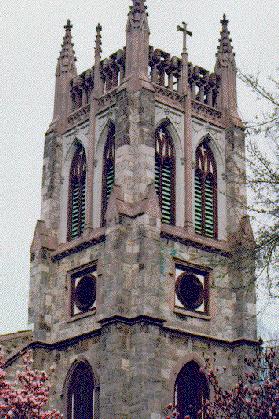|
Fordham University Church

|
by Dan Venturi
(photos: Fr. Nick Lombardi SJ)
|
Introduction
The Fordham University Church provides both the students and neighboring
parishioners with one of the finest examples of Gothic construction the
upper borough can offer.
Old St. John's as it is also known, is a Gothic revival structure in the
middle of The Bronx. The nave, buttresses, gargoyles, and reliquary are
all original elements that might be considered prerequisites for any Gothic
cathedral. The lantern and Gothic top bell
tower were later added but the original spire that the Gothic top replaced
was reminiscent of many great European cathedrals. There is a widely accepted
rumor that the legendary dark poet, Edgar Allen Poe, was inspired by the
University Church to pen his celebrated poem The
Bells. The bell that served as his inspiration is known as Old
Edgar Allen.
Construction
The University Church was built in 1845 as a seminary chapel and parish
church for surrounding farms. The University church was designed in 1846
by a man by the name of
Rodrigue (who now has a student coffee house on campus under his name).
It was built by the Rev. James Roosevelt Bailey, who was not only the third
president of the college but was also the nephew of Saint Elizabeth Seton
and cousin to Franklin and Theodore Roosevelt.
The six windows lining the nave were originally
gifts of King Louis Philippe of France to Archbishop Hughes for Old St.
Patrick's Cathedral (still standing on Mulberry Street). They did not fit,
however, and were given to the seminary chapel. The windows are wonderful
examples of nineteenth century realism. They depict the four evangelists
and St. Peter and St. Paul and they were created in Sevres, France by a
workshop that has been tied to the earliest stages of the Gothic revival.
The University Church underwent a major renovation in 1929 that saw its
capacity expand from 400 to 1,200. Three other major changes in appearance
were made .
- The replacement of the original spire with the Gothic top bell tower.
- The addition over the crossing of lantern patterned after those in Ely Cathedral and St. John's College in Cambridge.
- The windows in both the sanctuary and transepts
were replaced by the Munich windows that were previously housed in housed
in Keating Hall. The sanctuary windows are the Holy Family Windows while
the windows in the right transept are the Jesuit windows and those on the
left are the Apparition Windows.
The Interior and the Altar
In 1941, Cardinal Francis Spellman offered the church the old altar from
St. Patrick's. The altar was originally made in 1879. The University gladly
accepted Cardinal Spellman's gift and the altar now rests against the back
wall of the church.
Upon its arrival at Old St. John's, the university commissioned Mildreth
Meiere, a native New Yorker best known for her wonderful mosaics and murals
of the United States, to redo parts of the altar. Her three paintings
represent Our Lady Mediatrix of All Graces, the patroness of the University
Church, and were said to be "designed to impress the undergraduates with
several important truths. They emphasize the fact that great saints can
be women as well as men; laymen as well as religious; Popes, Cardinals,
and Lord Chancellors as well as simple friars: that wisdom and scholarship
have characterized the Church in every age and every land, and finally,
that the original churches are a treasured part of our cultural and spiritual
heritage. The center panel has the Virgin Mary, St. Joseph, St. Francis
of Assisi, St. Ignatius of Loyala, St. John the Baptist, St. Genevieve,
St. Isaac Jogues and St. Patrick. The left panel has St. Robert Bellarmine
S.J., St. Basil the Great, St. Thomas More, St. Bernard of Clairvaux, St.
Peter Canisius, S.J., and St. Augustine of Hippo. The right panel has St.
Bede the Venerable, St. Edmund Campion, S.J., St. John Chrysostom, St.
Gregory the Great, O.S.B., St. Columbia of Iona, and St. Thomas Aquinas,
OP .
Stations of the Cross
In 1948, Cardinal Spellman returned to Rosehill to dedicate a plaque commemorating
the 230 Fordham men that lost their lives in World War II. A year earlier,
Robert J. Gannon S.J., a former university president commissioned Italian
sculpture and artist Pietro Montana to design a Stations of the Cross to
commemorate the 100th anniversary of Old St. John's, which had passed unnoticed
two years earlier. His work was unveiled during the Easter season of 1952.
After Vatican II, the basement of the church was redesigned and was renamed
Thomas More Chapel.
The University Church was designated a New York City landmark in 1970 and
recently celebrated its sesquicentennial year in 1995.
Links
Medieval
New York | University Church Main | Lantern | Interior | Windows
The Internet History Sourcebooks Project is located at the History Department of Fordham University, New York. The Internet
Medieval Sourcebook, and other medieval components of the project, are located at
the Fordham University Center
for Medieval Studies.The IHSP recognizes the contribution of Fordham University, the
Fordham University History Department, and the Fordham Center for Medieval Studies in
providing web space and server support for the project. The IHSP is a project independent of Fordham University. Although the IHSP seeks to follow all applicable copyright law, Fordham University is not
the institutional owner, and is not liable as the result of any legal action.
© Site Concept and Design: Paul Halsall created 26 Jan 1996: latest revision 12 April 2024 [CV]
|